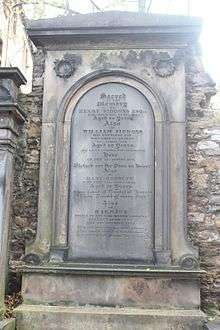Henry Siddons
Henry Siddons (1774–1815) was an English actor and theatrical manager, now remembered as a writer on gesture.


Life
Born on 4 October 1774, he was the eldest child of Sarah Siddons, and was educated at Charterhouse School, being intended by his mother for the church. He, however, joined the Covent Garden Theatre company, and made his first appearance as Herman in a play called Integrity, 8 October 1801. His future wife, Harriet Murray, the sister of William Murray, played in the same piece. His mother withdrew objections to his becoming an actor, and acted Lady Randolph to his Douglas on 21 May 1802, on the occasion of his benefit. He married on 22 June 1802, and remained a member of the Covent Garden Theatre until the spring of 1805.[1]
On 21 September 1805 Siddons made his first appearance at Drury Lane, playing Prince of Wales to Robert William Elliston's Hotspur in Henry IV. On 7 October he appeared as Romeo, and on the following evening as Sir G. Touchwood in the Belle's Stratagem. During his time at Drury Lane he played a variety of parts, including Banquo, Jaffier, George Barnwell, Douglas (in Percy), Claudio (in Much Ado About Nothing), and Rolla. He ended his connection with the London stage at the close of the season 1808–9. Largely through Sir Walter Scott's influence, he then secured the Edinburgh patent, and opened there on 14 November 1809 with The Honey Moon, in which he played the Duke; his wife appeared as Juliana.[1]
On starting his managerial career, Siddons aimed at producing plays with greater efficiency in all directions than before, at the Edinburgh Theatre; he was encouraged and supported by Scott. Siddons had an eye for talent, bringing on Daniel Terry and William Oxberry.[2][3] Joanna Baillie's Family Legend was produced by Siddons on 29 January 1810. On 15 January 1811 Siddons produced the Lady of the Lake; an adaptation in which he himself played Fitzjames. But he was fighting an uphill battle, and lost much money.
He died whilst visiting Edinburgh on 12 April 1815.[1] Siddons' sister, Cecilia Siddons, later married George Combe, a prominent Edinburgh lawyer, and the founder of the Edinburgh Phrenological Society. He was buried in Greyfriars Kirkyard in the centre of the city.[4] A large monument was erected to him in the south-west corner, just left of the entrance to the Covenanters Prison. His wife Harriot is buried with him. His son, William Siddons, died in Dublin but was reburied with his father.
Works
He adapted a work by Johann Jakob Engel, Ideen zu Einer Mimik from 1785; Engel was then director of the National Theatre in Berlin.[5] It appeared as Illustrations of Gesture and Action (1807). This book was consulted by Charles Darwin during the preparation of his The Expression of the Emotions in Man and Animals, published in 1872. The introduction explains the need to replace the references specific to German drama, rather than simply translate. The actual effect is more an uneasy grafting of techniques from the German neo-classical school of acting, onto a British stock.[5] The 1822 edition also draws on the Essay on Gesture of Michael William Sharp.[6]
He also wrote some plays; of one, The Friend of the Family, Scott wrote, "Siddons's play was truly flat, but not unprofitable". Other pieces by him were Time's a Tell-tale, and Tale of Terror, or a Castle without a Spectre (produced at Covent Garden on 12 May 1803).[1]
References
- 1 2 3 4
 Lee, Sidney, ed. (1897). "Siddons, Henry". Dictionary of National Biography. 52. London: Smith, Elder & Co.
Lee, Sidney, ed. (1897). "Siddons, Henry". Dictionary of National Biography. 52. London: Smith, Elder & Co. - ↑
 "Terry, Daniel". Dictionary of National Biography. London: Smith, Elder & Co. 1885–1900.
"Terry, Daniel". Dictionary of National Biography. London: Smith, Elder & Co. 1885–1900. - ↑ Stephens, John Russell. "Oxberry, William". Oxford Dictionary of National Biography (online ed.). Oxford University Press. doi:10.1093/ref:odnb/21045. (Subscription or UK public library membership required.)
- ↑ Monuments and monumental inscriptions in Scotland : The Grampian Society, 1871
- 1 2 Shearer West, The Image of the Actor: verbal and visual representation in the age of Garrick and Kemble (1991), pp. 78–80. Google Books.
- ↑ Google Books
- Attribution
![]() This article incorporates text from a publication now in the public domain: Lee, Sidney, ed. (1897). "Siddons, Henry". Dictionary of National Biography. 52. London: Smith, Elder & Co.
This article incorporates text from a publication now in the public domain: Lee, Sidney, ed. (1897). "Siddons, Henry". Dictionary of National Biography. 52. London: Smith, Elder & Co.